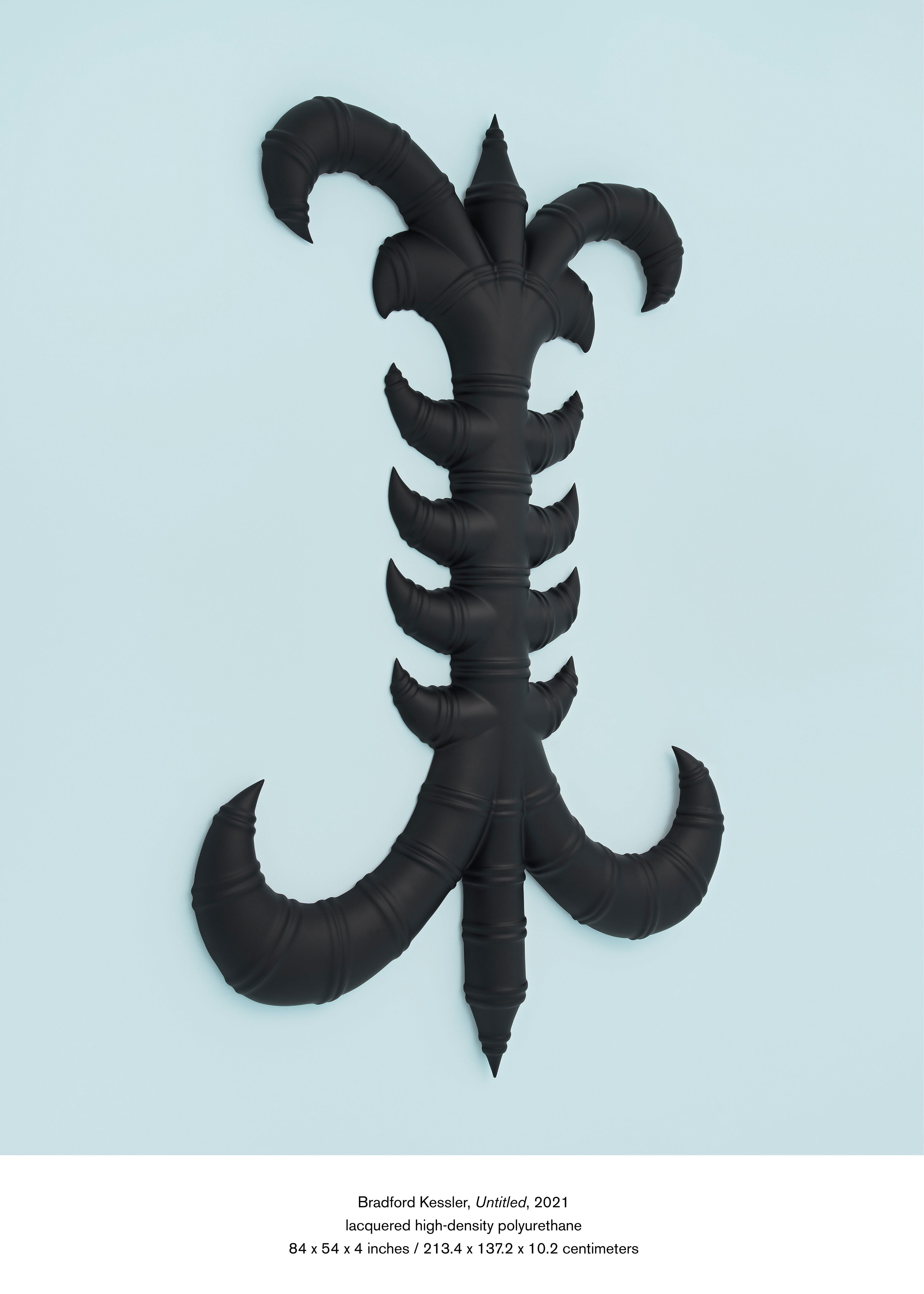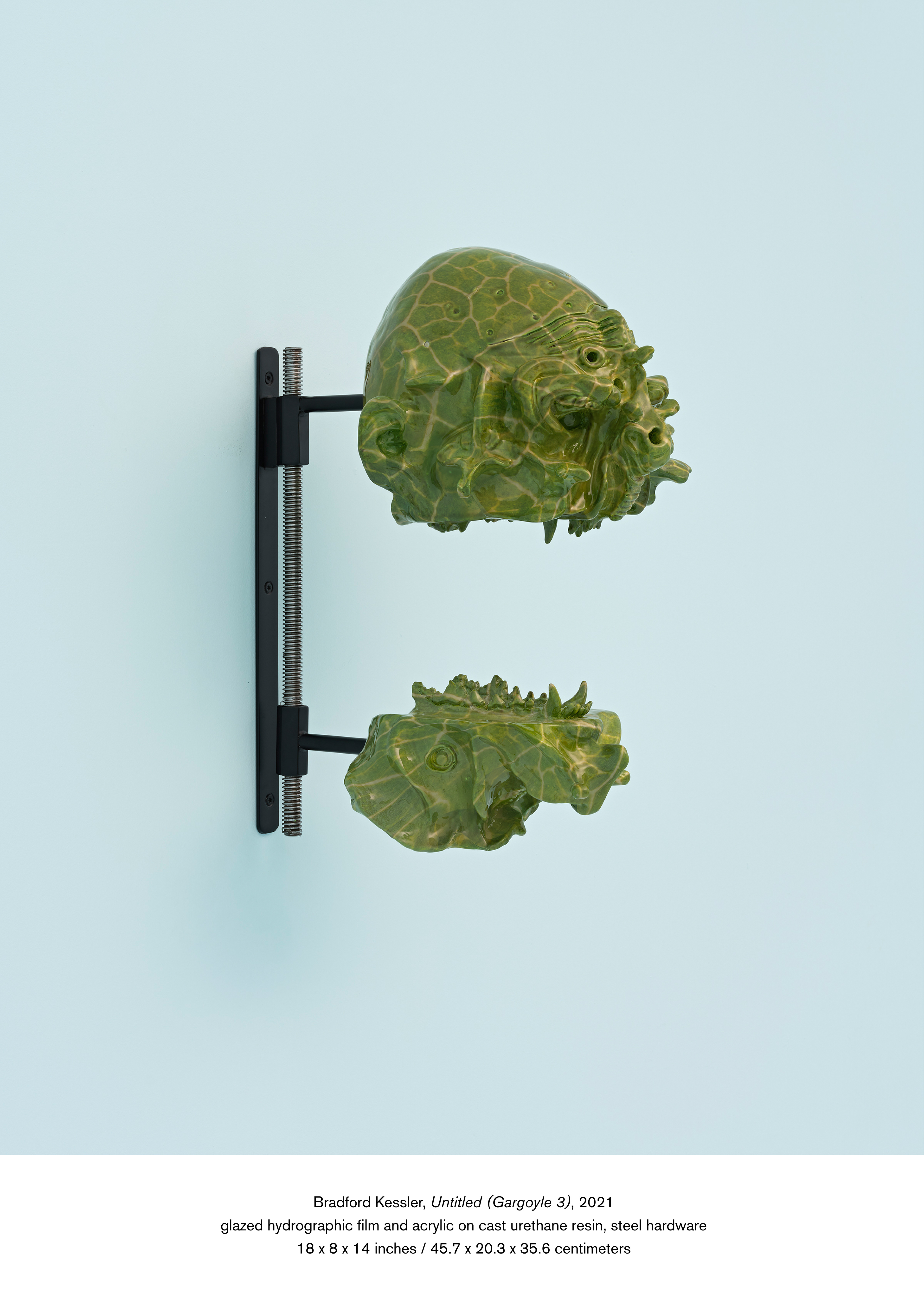


























ASHES/ASHES is pleased to present Bradford Kessler’s solo exhibition Deep Throats. The exhibition will be on view June 18 – August 1, 2021 with an opening on Friday, June 18th from 6–8pm.
The word gargoyle originates from the Latin ‘gargula’ for ‘throat’, with all similar words rooted in ‘gar’ for ‘swallow’. As an apotropaic device, gargoyles have long been used in architecture to turn away harm or evil influences. Centuries ago, the serpentine ornamentation of the gargoyle, parasitically attached to the exterior of the walls of worship, evoked the public’s fear of evil forces and their need for the Church’s protection. Animals were often anthropomorphized to create the figuration of gargoyles, as though these creatures from the natural world held the potential to demonically possess our human bodies. In Deep Throats, Kessler reverses this notion by modeling his gargoyles after human heads and morphing them into demonic creatures with skins of veiny green flora captured through macro photography. This gesture provokes the human exceptionalism which still sits on the throne of spiritual fantasies and institutional theologies. This great divide within the human psyche still holds our own species at a distance from nature in a mnemonic diorama of the artificial, alienated, and ghostly; our bodies simply a possessed capsule for that which is considered immortal. Kessler presents these decapitated heads, or ‘capsules of the psyche’, like hunted trophies divided at the mouth, with each half held apart by a modified steel device. These devices function like adjustable speculums which restrain the canine jaws of the gargoyles, preventing them from feeding and thus rendering the throats useless.
At the center of the exhibition, Kessler debuts Untitled, an emblematic wall work the artist sourced from the 1939 film The Wizard of Oz. Kessler paused the film as one of the Wicked Witch of the West’s ‘flying monkeys’ turns away to hunt down and capture Dorothy. The fleur-de-lis-esque motif appliquéd on the back of the flying monkey’s uniform was digitally rendered and merged with the N and Y of the Mets baseball team logo using 3D-modeling software, then CNC-milled into a larger-than-human scaled, arthropodic sculptural panel. This malevolent enigma in gunmetal black floats on the gallery wall like a sentinel exuding dark energies over Emerald City.
In Wrecker Gone to Seed, Kessler presents a ghostly figure depicted by empty cowboy boots fitted with customized blades, spikes, and spurs along with a pair of floating motorcycle gloves wielding a baseball bat. The invisible figure, styled for a Neo-Western, faces the corner of the room as if a child in eternal punishment. Kessler addresses the spectacle of human violence that is replayed endlessly by an entertainment industry which thrives on the public’s willingness to consume images of their fellow humans being butchered by homicidal maniacs, stalked by cyborgs, or eaten alive by voracious creatures. In addition to these violent screen re-enactments, the human species has another way of addressing predation-related anxieties which is through the role playing of defensive solidarity. Give us an enemy, and a mob with which to face down that enemy, and all anxiety temporarily dissipates in a surge of collective aggression towards the threat. Many culturally contrived events, from sacred rituals to televised team sports, allow us to recapture the elemental potency of the tribe united against the beast but few do so more reliably than war, if only because in war as opposed to sports, the threat of death is real.
Bradford Kessler (b. 1982; High Plains, Kansas) lives and works in New York. Kessler has had solo exhibitions at Interstate Projects, Brooklyn; 15 Orient, Brooklyn; Valentin, Paris; ASHES/ASHES, Los Angeles and New York; and 247365, New York. His work has been included in group exhibitions at: False Flag, Queens; Springsteen, Baltimore; MonChéri, Brussels; and Witte de With, Rotterdam. His work has been reviewed in Art in America, Modern Painters, Mousse, CURA, Flash Art, Dis, Vulture, and The New York Times.
